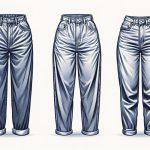Have you ever wondered how your favorite pair of jeans gets its vibrant color?
In this article, we’ll explore the fascinating world of denim fabric dyeing.
You’ll learn about the history of denim dyeing, the different types of dye used, and the traditional and modern techniques employed to achieve those iconic blue hues.
We’ll also discuss the role of chemicals in the dyeing process and delve into sustainable and eco-friendly practices.
Get ready to dive into the world of denim dyeing!
Table of Contents
The History of Denim Dyeing
The history of denim dyeing dates back to ancient civilizations, and it has played a significant role in the evolution of denim fashion. Denim, a sturdy cotton twill fabric, was originally used for workwear due to its durability. However, it wasn’t until the 19th century that denim started to gain popularity as a fashion fabric.
The first known use of indigo dye, which gives denim its characteristic blue color, can be traced back to ancient civilizations such as Egypt and India. These civilizations used natural indigo plants to dye fabrics, including denim-like materials, creating a rich blue hue that was highly sought after.
In the late 19th century, with the rise of the American Wild West, denim became synonymous with ruggedness and durability. It was during this time that denim dyeing techniques started to evolve. Synthetic indigo dyes were introduced, making the dyeing process more efficient and affordable.
As the popularity of denim continued to grow, new dyeing techniques were developed to enhance its appearance. Stonewashing, acid washing, and distressed effects became popular in the 1980s, giving denim a worn and aged look. These techniques involved the use of chemicals and abrasive materials to achieve the desired effect.
Types of Dye Used for Denim Fabric
When it comes to dyeing denim fabric, two key types of dyes stand out: indigo and sulfur.
Indigo, a traditional dye, is widely known for its iconic blue hue and has been used for centuries to create the classic denim look.
On the other hand, sulfur dye is popular for achieving black shades, providing a versatile option for those looking for a darker denim aesthetic.
Both dyes play a significant role in the world of denim, each offering its unique characteristics and appeal.
Indigo: Traditional Denim Dye
Indigo dye is traditionally used for coloring denim fabric. This natural dye has been used for centuries and is known for its deep blue color that fades beautifully over time. Traditional indigo dyeing techniques involve fermenting the indigo leaves, which releases the dye. The fabric is then repeatedly dipped in the dye bath and oxidized to achieve the desired shade. However, with advancements in technology, modern denim dyeing methods have been introduced. These methods use synthetic indigo dyes that are easier to work with and produce consistent results. They often involve a more controlled and automated process, reducing the time and effort required for dyeing. Despite the changes in dyeing methods, indigo still remains the iconic color associated with denim fabric.
| Traditional Indigo Dyeing Techniques | Modern Denim Dyeing Methods |
|---|---|
| Fermenting indigo leaves | Using synthetic indigo dyes |
| Repeatedly dipping the fabric | Controlled and automated process |
| Oxidizing to achieve desired shade | Reduced time and effort required |
Sulfur: Popular Black Dye
If you want a rich black color for your clothing, sulfur dye is a popular choice. This dyeing technique has been used for centuries to achieve deep, long-lasting black hues.
Here’s why sulfur dye is favored by many:
-
Intense Color: Sulfur dye creates a rich, opaque black color that is highly saturated and vibrant.
-
Excellent Colorfastness: Once dyed, the black color is resistant to fading, ensuring your clothing retains its deep shade for a long time.
-
Washability: Sulfur dye is known for its ability to withstand multiple washes without losing its color intensity.
-
Lightfastness: This dye is also resistant to light, preventing the black color from fading when exposed to sunlight.
With its intense color and excellent colorfastness, sulfur dye is a reliable choice for achieving a striking black hue in your garments.
Traditional Indigo Dyeing Techniques
Using a fermentation process, artisans create a dye bath from the indigo plant, which is then used to dye denim fabric. Traditional dyeing techniques have been used for centuries to achieve the iconic blue color of denim.
Indigo dye is derived from natural sources, such as the leaves of the indigofera tinctoria plant. The process begins by harvesting the indigo leaves and fermenting them in water. This fermentation process allows the indigo pigment to be released and oxidized, turning the liquid into a deep blue color.
The fabric is then immersed in the dye bath and left to soak for a period of time. Multiple dips and oxidization stages may be required to achieve the desired shade of blue. After dyeing, the fabric is rinsed to remove excess dye and then dried.
This traditional indigo dyeing technique not only creates a unique and vibrant blue color, but it also results in a durable and long-lasting dye that is resistant to fading. Artisans who practice these traditional dyeing techniques contribute to the preservation of cultural heritage and the production of high-quality denim fabric.
Modern Denim Dyeing Methods
Now, let’s explore the modern denim dyeing methods that have emerged with the advancements in technology. These methods not only make the process faster and more efficient but also have a lesser environmental impact compared to traditional techniques.
With modern technology, denim fabric can now be dyed using a range of innovative methods. Here are some of the most common techniques used today:
-
Rope Dyeing: In this method, the fabric is looped and twisted into a rope-like structure. The rope is then dipped into a vat of indigo dye, allowing the color to penetrate evenly throughout the fabric.
-
Laser Technology: Laser technology is used to create unique patterns and designs on denim fabric without the use of any dyes or chemicals. This method not only reduces water and chemical waste but also eliminates the need for post-dyeing treatments.
These modern dyeing methods have significantly reduced the environmental impact of denim production. They require less water and chemicals, leading to lower wastewater pollution. Additionally, laser technology eliminates the need for harsh chemicals, making it a safer and more sustainable option.
Overall, the integration of modern technology in denim dyeing has not only improved efficiency but also contributed to a more environmentally friendly approach in the fashion industry.
The Role of Chemicals in Denim Dyeing
In this discussion, we will explore the chemical dyeing process used in denim production and its impact on the environment.
You will gain a clear understanding of how chemicals are involved in the dyeing process and the potential consequences they can have on our ecosystem.
Chemical Dyeing Process Explained
The chemical dyeing process for denim fabric involves the use of synthetic dyes. These dyes are created through a series of chemical reactions that bond the color molecules to the fabric fibers.
Here’s a step-by-step breakdown of the chemical dyeing process:
- Preparation: The fabric is pre-treated to remove any impurities and prepare it for dyeing.
- Desizing: The sizing agents applied during fabric production are removed.
- Scouring: Any residual impurities and natural oils are eliminated.
- Dyeing: The fabric is immersed in a dye bath containing synthetic dyes.
- Fixation: Chemicals like salt or alkali are added to fix the dye to the fabric.
- Heating: The dye bath is heated to a specific temperature to enhance color absorption.
- Finishing: After dyeing, the fabric is rinsed, treated with chemicals for color fastness, and dried.
While chemical dyeing techniques provide vibrant and long-lasting colors, they also raise environmental concerns due to the use of synthetic dyes and chemical additives.
Efforts are being made to develop more sustainable and eco-friendly dyeing methods to minimize the impact on the environment.
Impact of Chemicals on Environment
To minimize the impact on the environment, you should consider exploring more sustainable and eco-friendly dyeing methods. Chemical pollution from traditional dyeing processes has significant environmental consequences. The release of toxic chemicals into waterways and the atmosphere contributes to water pollution, air pollution, and soil contamination. These chemicals can harm aquatic life, disrupt ecosystems, and even pose health risks to humans. Adopting sustainable dyeing methods can help mitigate these issues and promote environmental sustainability.
Consider the following table, which highlights the environmental impact of chemical dyeing processes compared to sustainable alternatives:
| Chemical Dyeing | Sustainable Dyeing |
|---|---|
| Releases toxic chemicals | Uses natural or low-impact dyes |
| Contributes to water pollution | Minimizes water consumption |
| Produces air pollutants | Emphasizes renewable energy sources |
| Contaminates soil | Focuses on biodegradable materials |
| Poses health risks | Prioritizes worker safety |
Sustainable and Eco-Friendly Dyeing Practices
Using sustainable and eco-friendly dyeing practices, denim fabric can be beautifully colored without harming the environment. By adopting these techniques, the fashion industry can reduce its ecological footprint and contribute to a more sustainable future. Here are some key points to consider:
-
Natural dyes: Instead of using synthetic chemicals, natural dyes derived from plants, fruits, and minerals can be used to color denim fabric. These dyes are biodegradable and do not release harmful pollutants into the environment.
-
Water conservation: Traditional dyeing methods require large amounts of water, which leads to water pollution and scarcity. Sustainable dyeing practices focus on reducing water consumption by utilizing innovative techniques like low-water dyeing and waterless dyeing. These methods not only minimize water usage but also decrease the energy required for the dyeing process.
-
Waste reduction: Sustainable dyeing practices also aim to minimize waste by utilizing by-products and recycling materials. This includes recycling dye bath water, reusing dyeing agents, and repurposing leftover dye materials. By reducing waste, the fashion industry can minimize its environmental impact and move towards a circular economy.
Implementing sustainable dyeing practices in the denim industry is crucial for reducing pollution, conserving resources, and protecting our environment. By choosing eco-friendly dyeing techniques, we can enjoy beautifully colored denim while also preserving the planet for future generations.
Challenges in Achieving Consistent Dyeing Results
Achieving consistent dyeing results can be challenging, but with sustainable and eco-friendly practices, you can overcome these obstacles and create beautiful, vibrant colors. When it comes to dyeing fabrics, particularly denim, there are several challenges that can arise. The first challenge is achieving consistent color throughout the fabric. This can be difficult due to variations in the fabric’s composition and the dyeing process itself. Additionally, maintaining colorfastness and preventing color bleeding during washing and wear is another challenge. To overcome these obstacles, it is important to implement proper dyeing techniques and use high-quality dyes that are specifically formulated for denim.
One strategy to achieve consistent color is to carefully control the dyeing process, including factors such as dye concentration, temperature, and duration. By closely monitoring these variables, you can ensure that the dye is evenly distributed throughout the fabric, resulting in a uniform color. Another approach is to use pre-treatments, such as scouring and bleaching, to remove impurities and prepare the fabric for dyeing. These pre-treatments can help to create a clean and even base for the dye to adhere to, improving color consistency.
In addition to these strategies, it is crucial to choose eco-friendly dyeing practices. This includes using low-impact dyes that have minimal environmental impact and are free from harmful chemicals. By prioritizing sustainability in the dyeing process, you can achieve consistent color while also minimizing the negative impact on the environment.
To better understand the challenges in achieving consistent dyeing results, here is a table highlighting some common obstacles and their possible solutions:
| Dyeing Challenge | Possible Solution |
|---|---|
| Uneven color distribution | Carefully control dyeing process variables |
| Color bleeding | Use high-quality dyes and proper fixation techniques |
| Colorfastness | Implement post-dyeing treatments such as washing and steaming |
| Environmental impact | Choose eco-friendly dyeing practices and low-impact dyes |
| Fabric composition variations | Conduct thorough fabric testing and adjust dyeing process accordingly |
Innovations in Denim Dyeing Technology
Now that you understand the challenges involved in achieving consistent dyeing results for denim fabric, let’s explore some exciting innovations in denim dyeing technology.
Manufacturers are constantly seeking eco-friendly and sustainable dyeing techniques to minimize the environmental impact of the denim production process. Here are some key innovations in sustainable denim dyeing:
-
Indigo fermentation: This technique involves using bacteria to ferment the indigo dye, reducing the need for harmful chemicals and water consumption. It also produces a unique, high-quality color.
-
Natural dyeing: Some companies are experimenting with natural dyes derived from plants, such as indigofera tinctoria or persicaria tinctoria. These natural dyes are biodegradable and have a lower impact on the environment.
-
Recycled water systems: To minimize water waste, some manufacturers are implementing closed-loop systems that recycle and reuse water during the dyeing process. This reduces water consumption and minimizes pollution.
-
Digital printing: Digital printing allows for precise and efficient dye application, reducing the amount of dye and water required. It also enables customization and eliminates the need for traditional dyeing methods.
These innovations in sustainable denim dyeing are paving the way for a more environmentally friendly and socially responsible denim industry. By adopting these eco-friendly dyeing techniques, manufacturers can reduce their carbon footprint and contribute to a more sustainable future.
Conclusion
In conclusion, you now have a clear understanding of how denim fabric is dyed.
From the traditional indigo dyeing techniques to the modern methods, the process has evolved over time.
Chemicals play a crucial role in achieving the desired color and consistency, but efforts are being made towards sustainable and eco-friendly dyeing practices.
Despite the challenges faced in achieving consistent results, innovations in denim dyeing technology continue to drive the industry forward.
With this knowledge, you can appreciate the art and science behind your favorite pair of jeans.
- What Is 100 T in Fabrics From China? Understanding Fabric Specifications - June 20, 2025
- What Fabric Is Used for Chino Pants? A Detailed Guide - June 20, 2025
- What Fabric Did China Contribute to the World? Historical Impact - June 20, 2025





